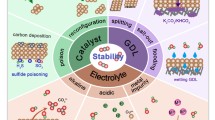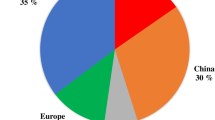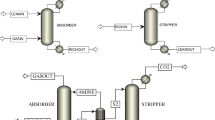Abstract
With increasing concerns on global warming, reduction of CO2 emission has become a hot issue and studies of CO2 capture and storage (CCS) technology in power plant applications are in progress. Oxy-fuel combustion is one of the several available technologies that intend to capture CO2. Since the combustion gas consists mainly of CO2 and H2O in oxy-fuel combustion systems, it is easy to separate CO2 from the flue gas using a simple mechanical method instead of complex chemical processes. There have been suggested a couple of power cycles using different recirculation fluids for combustion dilution purpose. This study aimed to investigate the influence of CO2 capture on the performance of two promising oxy-fuel combustion power cycles adopting H2O and CO2 as the recirculation fluid. Optimal integration between the carbon capture process and the power cycle was examined and the influences of carbon capture on the entire system performance were compared for the two cycles.
Similar content being viewed by others
References
J. W. Dijkstra, J. Marel, B. Kerkhof, B. Zwaan, M. Weeda, D. Jansen and M. Haines, Near Zero Emission Technology for CO2 Capture from Power Plants, Proc. of GHGT-8, Trondheim, Norway (2006).
M. Kanniche, R. Gros-Bonnivard, P. Jaud, J. Valle-Marcos, J. M. Amann and C. Bouallou, Pre-combustion, post-combustion and oxy-combustion in thermal power plant for CO2 capture, Appl. Therm. Eng., 30 (2010) 53–62.
J. Gibbins and H. Chalmers, Carbon Capture and Storage, Energ. Policy, 36 (2008) 4317–4322.
K. Pronske, L. Trowsdale, S. MacAdam, F. Viteri, F. Bevc and D. Horazak, An Overview of Turbine and Combustor Development for Coal-Based Oxy-Syngas Systems, ASME Paper GT2006-90816.
R. E. Anderson, S. MacAdam, F. Viteri, D. O. Davies, J. P. Downs and A. Paliszewski, Adapting Gas Turbines to Zero Emission Oxy-Fuel Power Plants, ASME Paper GT2008-51377.
F. J. Franco, T. Mina, G. Woollatt, M. Rost and O. Bolland, Characteristics of Cycle Components for CO2 Capture, Proc. of GHGT-8, Trondheim, Norway (2006).
W. Sanz, H. Jericha, B. Bauer and F. Gottlich, Qualitative and Quantitative Comparison of Two Promising Oxy-fuel Power Cycles for CO2 Capture, J. Eng. Gas Turb. Power, 130(3) (2008) 031702-1–031702-11.
H. Jerica, W. Sanz, E. Gottlich and F. Neumayer, Design Details of a 600MW Graz Cycle Thermal Power Plant for CO2 Capture, ASME Paper GT2008-50515.
B. Chorpening, G. A. Richards, K. H. Casleton, M. Woike, B. Willis and L. Hoffman, Demonstration of a Reheat Combustor for Power Production With CO2 Sequestration, J. Eng. Gas Turb. Power, 127(4) (2005) 740–747.
B. C. Park, J. L. Sohn, T. S. Kim, K. Y. Ahn and S. H. Kang, Influence of Operating Conditions on the Performance of a Oxy-Fuel Combustion Reference Cycle, J. Fluid Machi., 12(4) (2009) 30–36.
S. H. Tak, S. K. Park, T. S. Kim, J. L. Sohn and Y. D. Lee, Performance Analysis of an Oxy-fuel Combustion Power Generation System Based on Waste Heat Recovery: Influence of CO2 Capture, Trans. KSME, 33(12) (2009) 968–976.
Aspen Technology, AspenOne HYSYS, ver 2006.5, Aspen Technology, Inc., 2007.
H. Li, J. Yan and M. Anheden, Impurity Impacts on the Purification Process in Oxy-Fuel Combustion based CO2 Capture and Storage System, Appl. Energ., 86 (2009) 202–213.
H. Li and J. Yan, Preliminary Study on CO2 Processing in CO2 Capture from Oxy-Fuel Combustion, ASME Paper GT2007-27845.
J. Zachary and S. Titus, CO2 Capture and Sequestration Options: Impact on Turbo-Machinery Design, ASME Paper GT2008-50642.
L. M. Romeo, I. Bolea, Y. Lara and J. M. Escosa, Optimization of Intercooling Compression in CO2 Capture Systems, Appl. Therm. Eng., 29 (2008) 1744–1751.
A. Aspelund and K. Jordal, Gas Conditioning — The Interface between CO2 Capture and Transport, Int. J. Greenh. Gas Con., 1 (2007) 343–354.
A. Darde, R. Prabhaker, J. Trainer and N. Perrin, Air Separation and Flue Gas Compression and Purification Units for Oxy-coal Combustion Systems, Energy Procedia., 1 (2009) 527–534.
Author information
Authors and Affiliations
Corresponding author
Additional information
This paper was recommended for publication in revised form by Associate Editor Oh Chae Kwon
S. H. Tak received his MS in Mechanical Engineering from Inha University in 2010, and is now a support engineer at POSCO Power. His research topics include design and analysis of CCS (Carbon Capture and Storage) technology such as oxy-fuel combustion system and post-combustion system.
S. K. Park received his MS in Mechanical Engineering from Inha University in 2007, and is now a doctoral student at the same department. His research topics include performance analysis of fuel cell and fuel cell/gas turbine hybrid system and advanced energy systems.
T. S. Kim received his PhD in Mechanical Engineering from Seoul National University in 1995. He has been with the Dept of Mechanical Engineering, Inha University since 2000. His research areas include design and analysis of gas turbines and power plants, and aerodynamic performance analysis and test of gas turbine components. He is also active in the research topics of fuel cell and integrated energy systems.
J. L. Sohn received his PhD in Mechanical Engineering from the University of Alabama in Huntsville in 1986. He has been with School of Mechanical & Aerospace Engineering, Seoul National University since 2000, and is BK Associate Professor as of April 2010. His research area is design, simulation and test of gas turbine systems and components. He is also interested in researches on fuel cells and fuel cell/gas turbine hybrid systems.
Y. D. Lee received his MS degree from the School of Mechanical & Aerospace Engineering, Seoul National University in 2002, and is now a senior researcher at Korea Institute of Machinery & Materials (KIMM). His research area is design and thermodynamic analysis of power generation system. He is also interested in exergy analysis and exergoeconomic analysis for new concepts of power generation system including fuel cell, gasification and CCS.
Rights and permissions
About this article
Cite this article
Tak, S.H., Park, S.K., Kim, T.S. et al. Performance analyses of oxy-fuel power generation systems including CO2 capture: comparison of two cycles using different recirculation fluids. J Mech Sci Technol 24, 1947–1954 (2010). https://doi.org/10.1007/s12206-010-0623-x
Received:
Revised:
Accepted:
Published:
Issue Date:
DOI: https://doi.org/10.1007/s12206-010-0623-x




